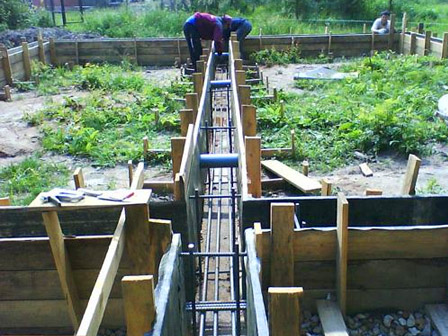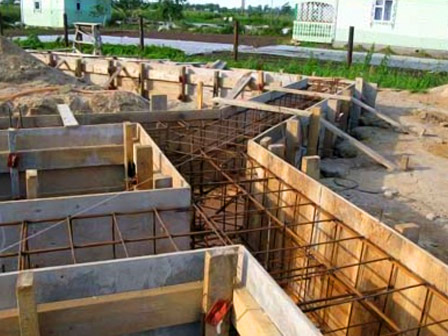The reinforced belt foundation is the most reliable design, so it is widely used in individual construction. For its device, it is necessary to install the reinforcement frame made of metal rods and wire. The ribbon foundation is exposed to compressing and tensile forces throughout the perimeter, so reinforcement of the upper and lower parts of the base is required.
Reinforcement Scheme and Technology
For the purpose of reinforcement, two tiers of longitudinal (horizontal) reinforcement are installed. For this purpose, the armature of the category AIII is used - a round profile with a diameter of from 10 to 16 mm with two longitudinal ribs and transverse protrusions directed along the screw line.
If the height of the base is more than 15 cm, then the installation of vertical fittings is required, which can be used class AI rods - smooth bars with a diameter of 6-8 mm. To compensate for loads acting along the transverse axes of the foundation, transverse reinforcement rods are mounted. Their main function - fixing the longitudinal tiers among themselves and prevent the appearance of cracks in concrete.
A transverse and vertical reinforcement is recommended to perform a single clamp that will connect the frame into the monolithic design. The setting step for the ribbon foundation is 3/8 of its height, but not less than 25 cm.
The frame is assembled from rods and clamps cleaned from rust. If necessary, they straighten up and cut. To connect individual reinforcement rods, knitting wires and a special hook are used. Welding is allowed only when mounting the rods with the corresponding labeling - the letter "C".
Reinforcement and corner
![]()
The creation of a rigid monolithic design involves competent performing angles reinforcement and base adjoints that are tested by concentrated loads. This uses fittings of class AII. In the reinforcement of angles, it is necessary to adhere to the basic rules:
- the rod bends into a special angle so that one end is plunged into one wall of the foundation, the other end is in another wall;
- the minimum stripping length of the rods to another wall is 40 diameters of reinforcement;
- it is not allowed to use simple linked crosshairs without additional transverse and vertical strips;
- if the length of the rod does not allow to bend to another wall, then M-shaped profiles are used to connect the rods on the corner;
- the distance between the frame clamps must be twice as fewer than in the tape structure.
How to calculate the number of necessary materials?
The number of reinforcement required to create a metal frame is determined based on the size of the foundation. For a base of a width of 40 cm, it is sufficient to use 4 longitudinal rods - two below and two from above.
The number of reinforcement for the installation of one row of the frame in the ribbon foundation with a size of 6x6 m will be 24 m. Taking into account the laying of 4 bar, the total number of longitudinal rods is 96 m. For the across and vertical reinforcement of the tape with a width of 0.3 m and a height of 1.9 m for each The compound with an indent of 5 cm from the surface of the concrete is necessary (30-5-5) x2 + (190-5-5) x2 \u003d 400 cm or 4 m smooth reinforcement.
Setting the clamp installation - 0.5 m, the number of compounds is: 24 / 0.5 + 1 \u003d 49 pcs. The total number of reinforcement required for the installation of the across and vertical elements is 4x49 \u003d 196 m.
Each connection has 4 intersections and requires 8 pieces of knitting wire. The average segment length for a bundle is 0.3 m. The total consumption of knitting wire is: 0.3x8x49 \u003d 117.6 m.
Photo of the reinforcement of the belt foundation: 
Working with monolithic foundation
The reinforcement of the monolithic belt foundation is performed according to simple geometric forms: a square or a rectangle. Mounting the frame is performed in the following sequence:
- On the bottom of the trenches, bricks are stacked with a height of 5 cm (to create a gap between the bottom surface of the foundation and frame);
- For mounting of the racket fittings, the template of the desired size is pre-manufactured, according to which the rods are cut;
- The longitudinal rods of the frame are stacked on bricks. It is advisable to use whole pieces of fittings;
- At a distance of 50 cm from each other to the longitudinal rods with a knitted wire, horizontal jumpers are tied. The length of each jumper is less than a 10 cm thickness (5 cm on each side);
- Vertical rods are attached to the corners of the cells, whose length is 10 cm less than the foundation height;
- Top longitudinal rods are mounted for vertical rods;
- The upper transverse rods are tied to the resulting corners.
If the rods of different diameters are used as longitudinal reinforcement, then larger rods are placed at the bottom and in the corners of the foundation.
Requirements and norms: What is said in SNIP?

For the belt foundation, SNIP 52-01-2003 determines the distance between the horizontal fins of the metal frame and the magnitude of the cross-reinforcement step. According to construction standards, the minimum distance between the reinforcement rods is determined depending on:
- diameter straightened;
- concrete aggregate size;
- the arrangement of the design in relation to the direction of concreting;
- method of laying;
- type of concrete seal.
The distance between the rods of the longitudinal reinforcement can not be more than 40 cm and less than 25 cm. The step of the transverse reinforcement is half the height of the workplace, but not more than 30 cm.
The diameter of the reinforcement is chosen in accordance with the requirements for the number of longitudinal reinforcement in the reinforced concrete structure. For a ribbon base, this value is at least 0.1% of the area of \u200b\u200bthe work section of the foundation. For example, for the foundation with a height of 1 m and a width of 0.5 m, the minimum cross-sectional area is 500 square meters. mm.
How does the foundation blowjob affect?
![]()
The main difference between the small-breeding and swallowed foundation is to the height of the base. In this regard, the foundations of deep downstream have a more developed side wall and the sole. For this reason, some experts are recommended to reinforce only the sole, and in the foundations of deep investigation, to carry out the strengthening of the outer part (shell) and the bottom.
Additionally, to enhance the metal frame in a finely breeded foundation, a mesh from a wire reinforcement with a diameter of 4 mm and the size of 10x10 cm cells can be installed.
During the reinforcement of the belt foundation, the strength and spatial rigidity of the structure significantly increases, the design of the reference part is enhanced.
A simple reinforcement technology allows you to independently perform work on the installation of a frame, to carry out the correct reinforcement of the foundation with your own hands and reduce the total cost of the foundation.
